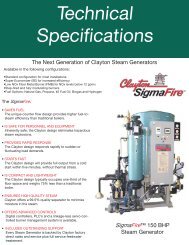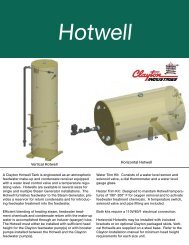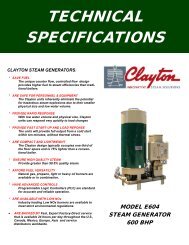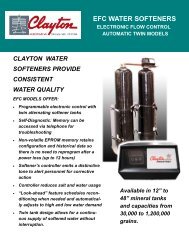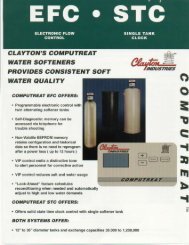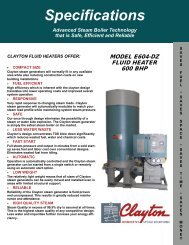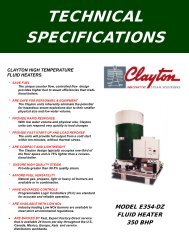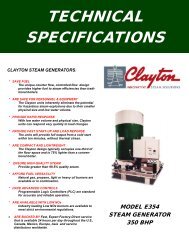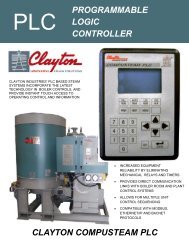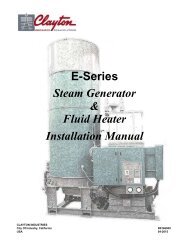SigmaFire Installation Manual, rev. F - Clayton Industries
SigmaFire Installation Manual, rev. F - Clayton Industries
SigmaFire Installation Manual, rev. F - Clayton Industries
Create successful ePaper yourself
Turn your PDF publications into a flip-book with our unique Google optimized e-Paper software.
Section II - General Information2.6 PIPING2.6.1 GeneralMake sure no excessive strain or load is placed on any <strong>Clayton</strong> piping or their connections. Constructsecure anchoring and support systems for all piping connected to the steam generator unit and associatedwater treatment package(s). Make sure anchoring and support systems keep motion and vibration to an absoluteminimum. Ensure no extraneous vibrations are transferred to or from <strong>Clayton</strong> equipment. DO NOT use<strong>Clayton</strong> connections as anchor points.Spring-loaded pipe hangers are not recommended. All customer connections are limited to +200pounds (+90 kg) of load and +150 foot-pounds (+200 N•m) of torque in all directions (X, Y, and Z). Properlydesigned flex lines and anchoring may be used to meet loading requirements. Fuel, combustion exhaustducts, and fresh air supply connections are not designed for loads.Pipe routes must not be obstructive or create any potential safety hazards, such as a tripping hazard.Pipe trenches should be considered for minimizing pipe obstructions. Piping used to transfer a hot fluidmedium must be adequately insulated.Pipe unions or flanges should be used at connection points where it is necessary to provide sufficientand convenient disconnection of piping and equipment.Steam, gas, and air connections should enter or leave a header from the top. Fluids, such as oil andwater, should enter or leave a header from the bottom. A gas supply connection must have a 12–18 inch (30–45 cm) drip leg immediately before <strong>Clayton</strong>’s fuel connection.P<strong>rev</strong>ent dissimilar metals from making contact with one another. Dissimilar metal contact may promotegalvanic corrosion.Globe valves are recommended at all discharge connections from <strong>Clayton</strong> equipment that mayrequire periodic throttling, otherwise gate or ball valves should be used to minimize pressure drops.2.6.2 SystemsTable 2-2 below is for steam generators rated below 250 psig (17.2 bar). It indicates the recommendedmaterial to be used for the various piping systems associated with the installation.Table 2-2: Piping RecommendationsSYSTEMRECOMMENDED MATERIAL/COMPONENTSSteam and Condensate System Steam and condensate system piping should be a minimum Schedule 40black steel (seamless Grade B preferred). Refer to ASME guidelines forproper pipe schedules. Steam headers should contain a sufficient numberof traps to remove condensed steam, and help p<strong>rev</strong>ent “water hammer.”The separator discharge requires one positive shut off globe valve at theseparator discharge flange.Blowoff/DrainASME codes require that all blow-off piping be steel with a minimumSchedule 80 thickness and all fittings be steel and rated at 300 psi. Boilerblow off piping should not be elevated.04/21/2015 2-13 Sect02_Genrl-SF_q.fm



